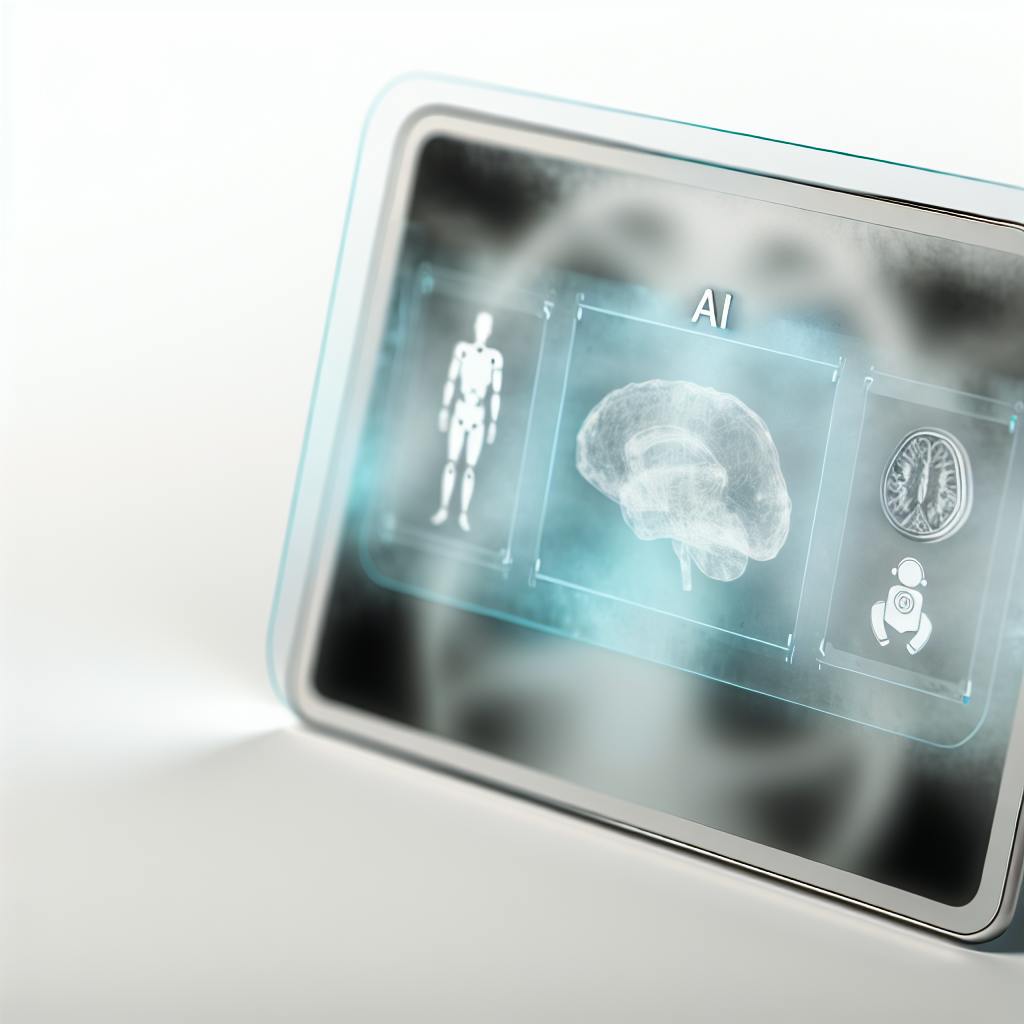AI is revolutionizing healthcare by optimizing resource allocation, reducing costs, and improving patient outcomes. This guide explores how AI can:
- Forecast Resource Needs - AI algorithms analyze data to predict patient volumes, staffing requirements, and medical supply needs.
- Allocate Resources Efficiently - AI distributes staff, equipment, and supplies based on predicted demand, ensuring optimal utilization.
- Enhance Patient Care - AI enables personalized treatment plans, reduces wait times, and ensures medical supply availability through predictive analytics.
- Cut Healthcare Costs - AI identifies areas for cost reduction while maintaining quality care by optimizing budget allocation and supply chain management.
By leveraging AI, healthcare organizations can overcome challenges like inefficient workflows, limited visibility, and budget constraints. This article provides a roadmap for integrating AI, addressing barriers to adoption, and harnessing AI's full potential in healthcare resource optimization.
Challenges in Managing Healthcare Resources
Managing healthcare resources is a complex task that poses several challenges to healthcare organizations. Here are some of the key challenges:
Demand Prediction
Hospitals and healthcare facilities struggle to accurately forecast patient volumes, leading to inefficient resource allocation. This can result in underutilization or overutilization of resources, ultimately affecting the quality of patient care.
Operational Inefficiencies
Inefficient workflows, inadequate staffing, and ineffective supply chain management lead to wasted resources, increased costs, and decreased productivity.
Limited and Ineffective Resource Allocation
Traditional approaches to resource allocation, such as manual forecasting and resource allocation, are often limited and ineffective. These approaches rely on historical data and do not take into account real-time changes in demand or supply.
Data Silos and Lack of Visibility
Healthcare organizations often have disparate systems and data sources, making it difficult to access and analyze data in real-time. This lack of visibility makes it challenging to identify areas of inefficiency and opportunities for improvement.
Budget Constraints and Regulatory Requirements
Healthcare organizations face significant challenges in managing resources due to limited budgets and stringent regulatory requirements. They must balance the need to provide high-quality patient care with the need to operate efficiently and effectively.
By understanding these challenges, healthcare organizations can begin to address them using AI-driven solutions, which can help optimize resource allocation, reduce costs, and improve patient outcomes. In the next section, we will explore how AI can help cut healthcare costs.
AI Cuts Healthcare Costs
The healthcare industry faces significant inefficiencies, leading to waste of resources. AI can help mitigate these issues by predicting future needs and optimizing budget allocation.
AI Forecasts Resource Needs
AI algorithms analyze historical and real-time data to forecast and plan resource needs. This enables healthcare organizations to anticipate demand and allocate resources accordingly, reducing waste and improving patient care.
| Benefits of AI Forecasting | Description |
|---|---|
| Optimized staffing levels | Reduces overtime costs and improves employee satisfaction |
| Improved supply chain management | Reduces costs and improves procurement processes |
AI Manages Healthcare Budgets
AI aids in effective budget management by identifying areas to reduce costs while maintaining care quality. By analyzing large datasets, AI provides actionable insights to optimize resource allocation.
| Benefits of AI Budget Management | Description |
|---|---|
| Identifies areas for cost reduction | Maintains care quality while reducing waste |
| Optimizes supply chain management | Reduces costs and improves procurement processes |
By leveraging AI to optimize resource allocation and budget management, healthcare organizations can significantly reduce costs and improve patient outcomes. In the next section, we will explore how AI can improve patient care.
AI Improves Patient Care
AI technology has the potential to significantly improve patient care by providing personalized and efficient treatment plans. By analyzing patient data, AI systems can identify potential bottlenecks in care delivery, ensuring timely and effective treatment.
Personalized Care from AI
AI-driven personalized medicine allows healthcare providers to tailor treatment plans to individual patients' needs. By analyzing a patient's medical history, genetic profile, and lifestyle, AI algorithms can predict the most effective treatment options.
| Benefits of Personalized Care | Description |
|---|---|
| Early intervention and prevention | Identifies patients at risk of developing chronic diseases |
| Empowers patients | Provides personalized health advice through AI-driven chatbots |
AI Enhances Patient Experience
Predictive analytics is a key aspect of AI in healthcare, enabling healthcare providers to anticipate resource shortages and address them proactively. By analyzing patient data and medical trends, AI algorithms can identify potential bottlenecks in care delivery, ensuring that patients receive timely and effective treatment.
| Benefits of Predictive Analytics | Description |
|---|---|
| Reduces wait times | Predicts patient volume and adjusts staffing levels accordingly |
| Ensures medical supply availability | Predicts and manages medical supply needs |
By leveraging AI to improve patient care, healthcare providers can enhance the patient experience, reduce costs, and improve outcomes. In the next section, we will explore how AI allocates healthcare resources smartly.
AI Allocates Healthcare Resources Smartly
Analyzing Trends and Patient Flows for Agile Response
Healthcare resource allocation is a complex task that requires careful planning and execution. AI can play a crucial role in optimizing resource allocation by analyzing trends and patient flows, enabling healthcare providers to respond quickly to variable demands and crises.
AI Distributes Staff and Equipment Efficiently
AI can aid in the allocation of medical personnel and equipment based on predictive needs. By analyzing patient flow, AI algorithms can identify areas where staff and equipment are needed most, ensuring that resources are distributed efficiently.
| Benefits of AI-driven Resource Allocation | Description |
|---|---|
| Improved patient outcomes | Ensures timely and effective treatment by allocating resources where needed most |
| Enhanced resource utilization | Optimizes staff and equipment allocation, reducing waste and improving efficiency |
| Better decision-making | Provides data-driven insights to inform resource allocation decisions |
AI Plans for Healthcare Emergencies
AI can prepare healthcare facilities for unexpected events like epidemics or natural disasters through dynamic resource allocation. By analyzing historical data and real-time trends, AI algorithms can predict the likelihood of an emergency situation, enabling healthcare providers to proactively allocate resources.
| Benefits of AI-driven Emergency Planning | Description |
|---|---|
| Enhanced preparedness | Enables healthcare providers to proactively allocate resources in response to predicted emergencies |
| Improved response times | Reduces the time it takes to respond to emergencies, saving lives and reducing the risk of complications |
| Better resource utilization | Optimizes resource allocation, reducing waste and improving efficiency in emergency situations |
sbb-itb-527d68c
Building an AI System for Healthcare Resources
Data Analytics: The Foundation of AI Optimization
Healthcare providers can gain valuable insights into patient flow, resource utilization, and demand patterns by leveraging large datasets. This information enables AI systems to make informed decisions on resource allocation, ensuring that healthcare facilities are adequately prepared to meet patient needs.
Key Benefits of Data Analytics:
| Benefit | Description |
|---|---|
| Identifies trends and patterns | Analyzes electronic health records (EHRs), patient demographics, and historical trends |
| Predicts patient admissions and resource utilization | Enables proactive allocation of staff, beds, equipment, and supplies |
| Optimizes workflow efficiency | Minimizes wait times and improves patient satisfaction |
AI Models Forecast Resource Needs
Simulation and modeling are essential components of AI-driven resource optimization. By forecasting demand and resource utilization, AI models can identify potential bottlenecks and inefficiencies in healthcare operations.
How AI Models Work:
1. Analyze patient flow, staff availability, and equipment capacity 2. Predict resource needs and optimize allocation 3. Simulate different scenarios to test and refine resource allocation strategies
AI Recommends Resource Allocation
Decision support systems (DSS) offer real-time recommendations for resource allocation, ensuring that healthcare providers make informed decisions based on data-driven insights.
Key Features of DSS:
| Feature | Description |
|---|---|
| Analyzes patient data and resource availability | Provides optimized resource allocation plans |
| Identifies opportunities for cost savings | Recommends strategies for reducing costs and improving resource allocation |
AI Monitoring Ensures Continuous Improvement
Continuous monitoring is essential for ensuring that AI-driven resource optimization systems remain effective and relevant over time.
Key Benefits of AI Monitoring:
| Benefit | Description |
|---|---|
| Tracks key performance indicators (KPIs) | Identifies areas for improvement and refines resource allocation strategies |
| Updates and refines AI algorithms | Ensures that AI systems remain effective and efficient in meeting patient needs |
Integrating AI in Healthcare Operations
Collaboration for AI Development
Healthcare professionals and AI developers must work together to successfully integrate AI in healthcare operations. This collaboration ensures that AI solutions are tailored to specific healthcare needs, leading to more effective and efficient healthcare delivery.
Benefits of Collaboration:
| Benefit | Description |
|---|---|
| Accurate AI systems | Clinicians provide valuable insights into patient care and healthcare operations |
| Effective AI development | Data scientists offer expertise in AI development and deployment |
| Improved healthcare delivery | AI solutions are tailored to specific healthcare needs |
Adapting AI for Healthcare Needs
Healthcare organizations must adapt AI implementations to address various healthcare scenarios effectively. This requires a deep understanding of the healthcare landscape, including patient care, clinical workflows, and operational challenges.
Key Considerations:
| Consideration | Description |
|---|---|
| Healthcare data challenges | Addressing data quality, security, and privacy concerns |
| Unique healthcare needs | Tailoring AI solutions to specific healthcare scenarios |
| Patient care and safety | Ensuring AI systems maintain the highest standards of patient care and safety |
By following these guidelines, healthcare organizations can successfully integrate AI in healthcare operations, leading to improved patient outcomes and operational efficiency.
Overcoming AI Adoption Barriers
Healthcare organizations face several challenges when adopting AI solutions. These barriers can hinder the successful integration of AI in healthcare operations.
Data Privacy and Security Concerns
Healthcare institutions must balance innovation with patient data privacy and security. To overcome this barrier, collaborative efforts between healthcare providers and regulatory bodies can help establish robust data protection regulations.
Limited AI Literacy among Healthcare Professionals
Healthcare professionals may lack understanding and awareness of AI and its applications. Comprehensive training programs can enhance their AI literacy, enabling them to leverage AI more effectively in patient care.
Regulatory Compliance and Approval Processes
Stringent regulatory processes for approving AI-based medical devices and treatments can slow down adoption. Regulatory bodies can work closely with technology developers to strike a balance between ensuring safety and promoting innovation.
| Barrier | Solution |
|---|---|
| Data privacy and security concerns | Collaborative efforts between healthcare providers and regulatory bodies |
| Limited AI literacy among healthcare professionals | Comprehensive training programs |
| Regulatory compliance and approval processes | Close collaboration between regulatory bodies and technology developers |
By understanding and addressing these barriers, healthcare organizations can overcome the challenges of AI adoption and harness the full potential of AI technologies to enhance patient care, improve outcomes, and optimize operational efficiency.
AI's Future Impact on Healthcare Resources
The future of healthcare resource optimization lies in the effective integration of AI technologies. As the healthcare industry continues to evolve, AI will play a crucial role in enhancing patient outcomes, improving operational efficiency, and reducing costs.
AI's Role in Healthcare Operations
AI will revolutionize healthcare operations management, from scheduling and resource allocation to patient communication and feedback. By automating administrative tasks, AI will free up healthcare professionals to focus on providing high-quality patient care.
Predictive Analytics and Resource Allocation
AI-driven predictive analytics will enable healthcare organizations to anticipate and prepare for future challenges, ensuring that resources are allocated effectively and efficiently.
Unlocking AI's Potential
As the healthcare industry embarks on this transformative journey, it is essential for healthcare providers to leverage AI technologies to stay ahead of the curve. By doing so, they can unlock the full potential of AI and create a more sustainable, efficient, and patient-centered healthcare system.
| Benefits of AI in Healthcare | Description |
|---|---|
| Enhanced patient outcomes | AI improves patient care through data-driven insights |
| Improved operational efficiency | AI automates administrative tasks, freeing up healthcare professionals |
| Reduced costs | AI optimizes resource allocation, reducing waste and improving efficiency |
By embracing AI technologies, healthcare providers can create a more efficient, effective, and patient-centered healthcare system.


